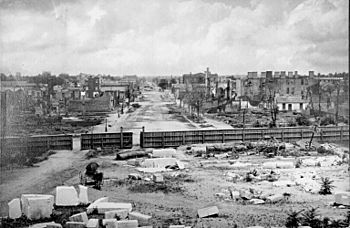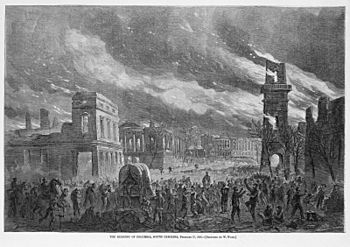Columbia, South Carolina, in the American Civil War facts for kids
Columbia, the capital city of South Carolina, played a big role during the American Civil War. It was an important place for the Confederate States Army, providing supplies and serving as a political center. However, much of the city was destroyed in 1865. This happened when Union forces, led by William T. Sherman, took over Columbia during the final months of the war. People debated for a long time whether Sherman deliberately burned the city. Today, historians believe many things caused the fires.
Contents
Columbia's Role in the Civil War
Columbia became a city in 1786 and grew very quickly. By the 1850s, it was the largest inland city in the Carolinas. Railroads helped the city grow, mainly by moving cotton. Cotton was super important to Columbia's economy. Almost all business in the city before the Civil War was connected to cotton.
A very important meeting happened in Columbia. On December 17, 1860, the First Baptist Church hosted the South Carolina Secession Convention. Here, delegates voted to leave the United States, 159 to 0. This created the short-lived Republic of South Carolina. Because of its central location, Columbia was also a good place for other important meetings for the Confederacy.
Camp Sorghum: A Prisoner Camp
In 1864, a Confederate prisoner-of-war camp called Camp Sorghum was set up near Columbia. It was a 5-acre open field with no walls or buildings. Prisoners were given cornmeal and sorghum molasses to eat, which is how the camp got its name. Conditions were very bad. There was little food, clothing, or medicine. Many prisoners and even guards got sick and died. Because there were no strong fences, many prisoners managed to escape.
Union Army Takes Columbia
After a battle on February 3, 1865, Union forces moved towards Columbia. On February 17, 1865, Columbia officially gave up to General Sherman's army. Confederate soldiers, led by Wade Hampton III, left the city.
When Union soldiers entered, they found many freed Federal prisoners and formerly enslaved people. The city became very chaotic. Fires started in different parts of Columbia, and strong winds quickly spread the flames. Most of the city center was destroyed. City firefighters struggled to put out the fires, and many soldiers were also trying to help.
The burning of Columbia has been debated ever since. Some people said the fires were accidental. Others believed it was a deliberate act of revenge by the Union army. Some even thought retreating Confederate soldiers started fires by burning cotton bales. On the same day, Confederates also left Charleston. On February 18, Sherman's forces destroyed anything in Columbia that had military value. This included railroad depots, warehouses, and arsenals.
Many important buildings were burned. This included the old South Carolina State House and the inside of the new State House, which was still being built. The Arsenal Academy also burned down. The only building that survived there is now the South Carolina Governor's Mansion.

The debate about the burning started even before the war ended. Southern newspapers quickly claimed it was a terrible act by the North. General Sherman said strong winds and the retreating Confederate soldiers, who set fire to cotton bales in the streets, were to blame. Sherman denied ordering the city to be burned. However, he did order military buildings, like the Confederate Printing Plant, to be destroyed.
According to historian Marion Lucas, the destruction of Columbia was not caused by one single event or person. Instead, it was the result of eight days of chaos, stealing, and fires. These were all common problems during wartime. It's hard to know for sure how the fires started. The most likely reason is that they began from burning cotton on Richardson Street. Columbia had hundreds of cotton bales in its streets, making it a firetrap. Some of these were already burning before Sherman arrived, and strong winds spread the flames across the city.
In 2015, The State newspaper shared "5 myths about the Burning of Columbia":
- Sherman ordered the burning of Columbia.
- All of Columbia burned.
- There was a "battle" for Columbia.
- Union soldiers burned the Congaree River bridge.
- First Baptist Church was saved by an African-American caretaker.
Rebuilding Columbia
After the war, during a time called Reconstruction, Columbia received a lot of attention. Reporters, travelers, and tourists came to see South Carolina's capital. They wanted to witness a state government where some members were formerly enslaved people. The city also started to recover after the terrible fire of 1865. New buildings were constructed, and repairing railroad tracks outside the city created jobs for people.
Civil War Tourism in Columbia
Today, you can visit places in Columbia that tell the story of the Civil War.
- The Confederate Relic Room and Military Museum has many artifacts from the Confederate period in South Carolina.
- You can still see six impacts from Sherman's cannonballs on the outside of the State House. These spots were never repaired and are now marked with bronze stars.
- Tourists can follow the path General Sherman's army took to enter the city. You can also see buildings or parts of buildings that survived the fire. A special walking tour about the Civil War is available.



